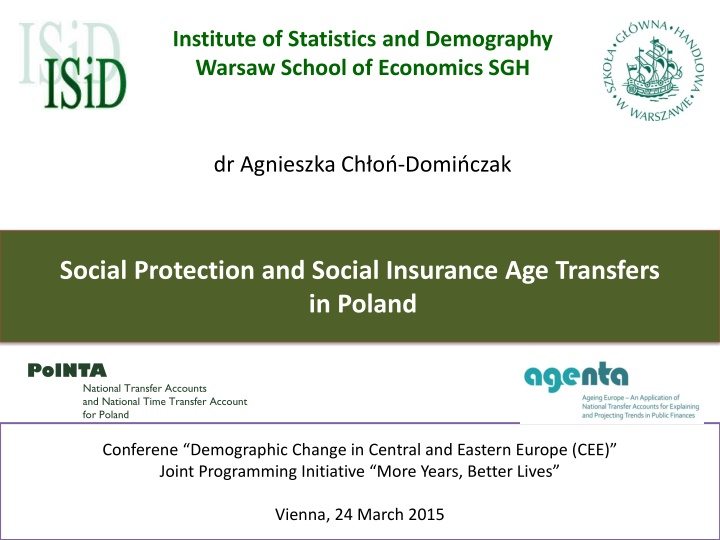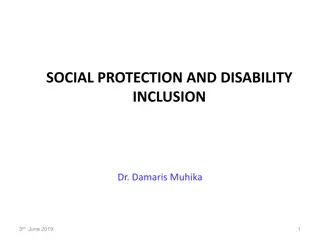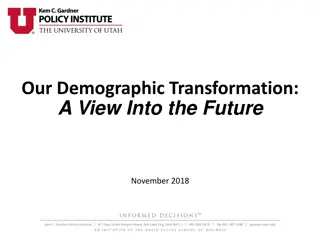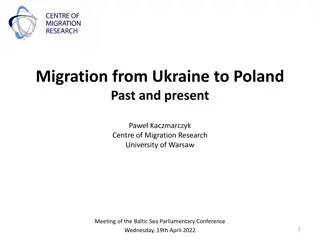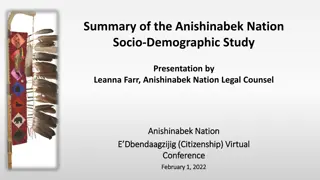Social Protection & Demographic Trends in Poland
This content explores the demographic situation, social insurance system, and social expenditure in Poland. It covers topics such as aging population, social protection spending compared to EU-15, and the structure of social expenditure from 2000 to 2012.
Uploaded on Feb 17, 2025 | 3 Views
Download Presentation

Please find below an Image/Link to download the presentation.
The content on the website is provided AS IS for your information and personal use only. It may not be sold, licensed, or shared on other websites without obtaining consent from the author.If you encounter any issues during the download, it is possible that the publisher has removed the file from their server.
You are allowed to download the files provided on this website for personal or commercial use, subject to the condition that they are used lawfully. All files are the property of their respective owners.
The content on the website is provided AS IS for your information and personal use only. It may not be sold, licensed, or shared on other websites without obtaining consent from the author.
E N D
Presentation Transcript
Institute of Statistics and Demography Warsaw School of Economics SGH dr Agnieszka Ch o -Domi czak Social Protection and Social Insurance Age Transfers in Poland PolNTA National Transfer Accounts and National Time Transfer Account for Poland Conferene Demographic Change in Central and Eastern Europe (CEE) Joint Programming Initiative More Years, Better Lives Vienna, 24 March 2015
Outline Demographic situation in Poland Social insurance in Poland: basic facts Benefits and revenues of social insurance system by age groups and gender Who receives what kind of benefits? Change of pension expenditure age profiles in time Summary
Population ageing combined with waves of baby booms and baby busts 800000 96 90 700000 84 78 600000 72 66 500000 60 54 400000 48 42 300000 36 30 200000 24 18 12 100000 6 0 0 -400000 -200000 0 200000 400000 100+ 0 5 10 15 20 25 30 35 40 45 50 55 60 65 70 75 80 85 90 95 2012 Men 2012 Women 2008 Men 2004 Total 2008 Total 2012 Total 2008 Women 2004 Women 2004 Men Gradual shift of post-war baby-boom generation towards retirement age Increased size of transfers from social insurance to retired population Reduced mortality and lower fertility after 1989 Source: GUS
Social expenditure in Poland compared to the EU-15 The level of social protection expenditure in Poland is lower than the EU average Widening gap in recent years is caused also by the developments of the economy (lack of recession in Poland) 35.0 30.0 25.0 20.0 Poland EU-15 15.0 10.0 5.0 0.0 2000 2001 2002 2003 2004 2005 2006 2007 2008 2009 2010 2011 2012 Source: ESPROSS Eurostat
Structure of social expenditure 2000 Also structure of social expenditure differs between Poland and EU-15 Poland spends relatively more on pensions and survivor benefits while less on health care, family and unemployment Between 2000 and 2012 there are some shifts in structure of benefits: Decline in share of expenditure on disability Increase in share of expenditure on pensions and health care Social insurance transfers compose the bulk of social protection expendiuture in Poland 6%2% 1% 0% 5%5% 1% 28% 9% 20% 11% 7% 14% 8% 44% 39% 6%2% 2% 2006 1% 5%3% 1% 8% 29% 20% 11% 6% 10% 8% 49% 39% 2012 Sickness/Health care 5%2% 1% Disability 1% 1% 4% 2% 8% 30% 24% 11% Old age 6% Survivors 8% Family/Children 7% 49% 41% Unemployment Housing Social exclusion
Social Insurance in Poland One of the largest cash transfer systems covering all employees and self-employed Financed from contributions and government subsidies % of Total Pension expenditure (% GDP) Insured people ('000) Pensioners ('000) expenditure covered by contributions 71,2 61,1 69,4 expenditure (% GDP) 2004 2008 2012 12 857 14 513 14 604 7 175 7 414 7 351 11,8 10,4 10,7 10,8 9,6 9,8 Source: ZUS
Data analysed Part of the development of NTA profiles for Poland Data availability: 2012 by age cohort and gender: data on transfers including: Pensions: old-age, disability, survivors Pre-retirement transfers (non-contributory) Short-term benefits: maternity and sickness benefits data on contribution revenue based on the information on wage levels covered by social insurance 2004 and 2008 by age cohort and sex: data on pension transfers (old-age, disability and survivors) Data on transfers: as of December of a given year (monthly data) Data on contributions: annual data, re-calculated to monthly level
2012: Transfers by type 800000000 ST sickness M 700000000 ST sickness F ST maternity M 600000000 ST maternity F ST father leave PRERET M 500000000 PRERET F WIP M 400000000 WIP F Bridge M 300000000 Bridge F DI M DI F 200000000 S M S F 100000000 OA M OA F 0 99+ 0 3 6 9 12 15 18 21 24 27 30 33 36 39 42 45 48 51 54 57 60 63 66 69 72 75 78 81 84 87 90 93 96 Source: own calculations
2012: transfers by type and sex 400000000 400000000 350000000 350000000 300000000 300000000 250000000 250000000 200000000 200000000 150000000 150000000 100000000 100000000 50000000 50000000 0 0 0 5 10 15 20 25 30 35 40 45 50 55 60 65 70 75 80 85 90 95 0 5 10 15 20 25 30 35 40 45 50 55 60 65 70 75 80 85 90 95 OA F S F DI F Bridge F OA M S M DI M WIP F PRERET F ST maternity F ST sickness F Bridge M WIP M PRERET M Source: own calculations ST father leave ST maternity M ST sickness M
Comparison of transfers per capita by sex (real prices of 2012) Male Female 2500 2500 2000 2000 1500 1500 1000 1000 500 500 0 0 0 5 10 15 20 25 30 35 40 45 50 55 60 65 70 75 80 85 90 95 0 5 10 15 20 25 30 35 40 45 50 55 60 65 70 75 80 85 90 95 2008 Total M 2012 Total M 2004 Total M 2008 Total F 2012 Total F 2004 Total F Source: own calculations
Summary Demographic shift leads to increased expenditure due to ageing of the post-war baby-boom generation Pensions are the main source of transfers from social insurance: Disability and survivor pensions increase prior to legal retirement age Survivor pensions to widows are an important transfers for women 70+ 2008 reform of early retirement transfers led to a shift of age profiles of transfers for ages 55-60
